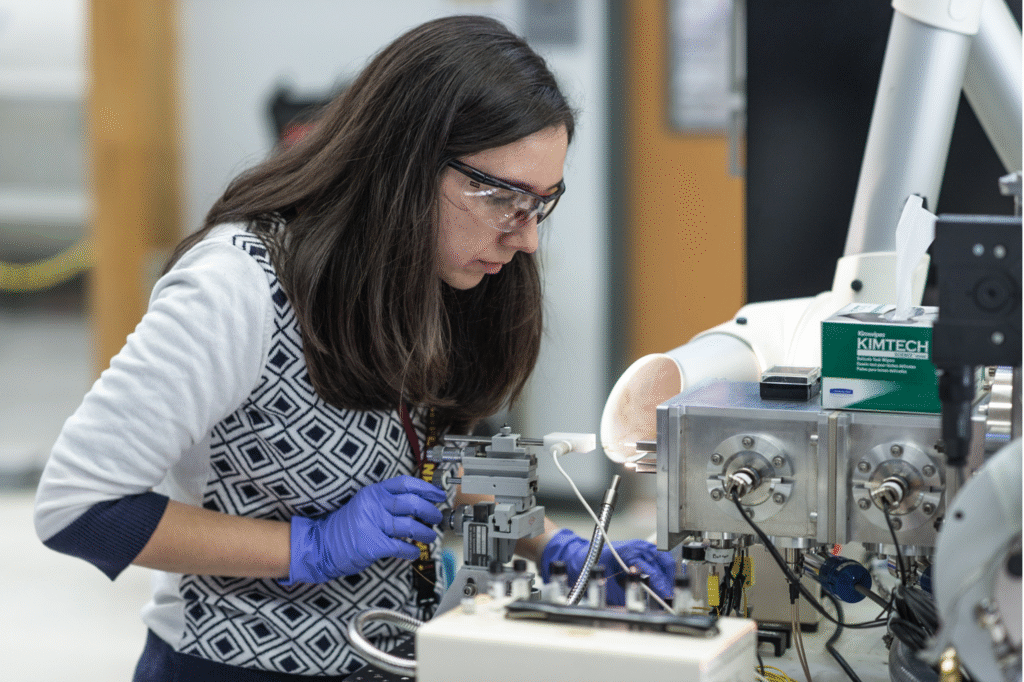
Building a MagLab ecosystem: Is it FSU’s job or a wide array of stakeholders?
Florida State University secured the bid and has drawn world-class researchers to the MagLab. It has kept the MagLab operational, but without the lavish upgrades seen elsewhere on campus (Doak Campbell Stadium, student union, etc.). The successes at the MagLab have primarily been the product of the scientists and researchers doing the actual work. […]
September 15, 2025Red Tape Florida
Building a MagLab ecosystem: Is it FSU’s job or a wide array of stakeholders?

Part 4 of a series
Florida State University secured the bid and has drawn world-class researchers to the MagLab. It has kept the MagLab operational, but without the lavish upgrades seen elsewhere on campus (Doak Campbell Stadium, student union, etc.). The successes at the MagLab have primarily been the product of the scientists and researchers doing the actual work.
And when it comes to translating that scientific prestige into broader economic benefits for Tallahassee, FSU’s role becomes more complex and, at times, restrictive.
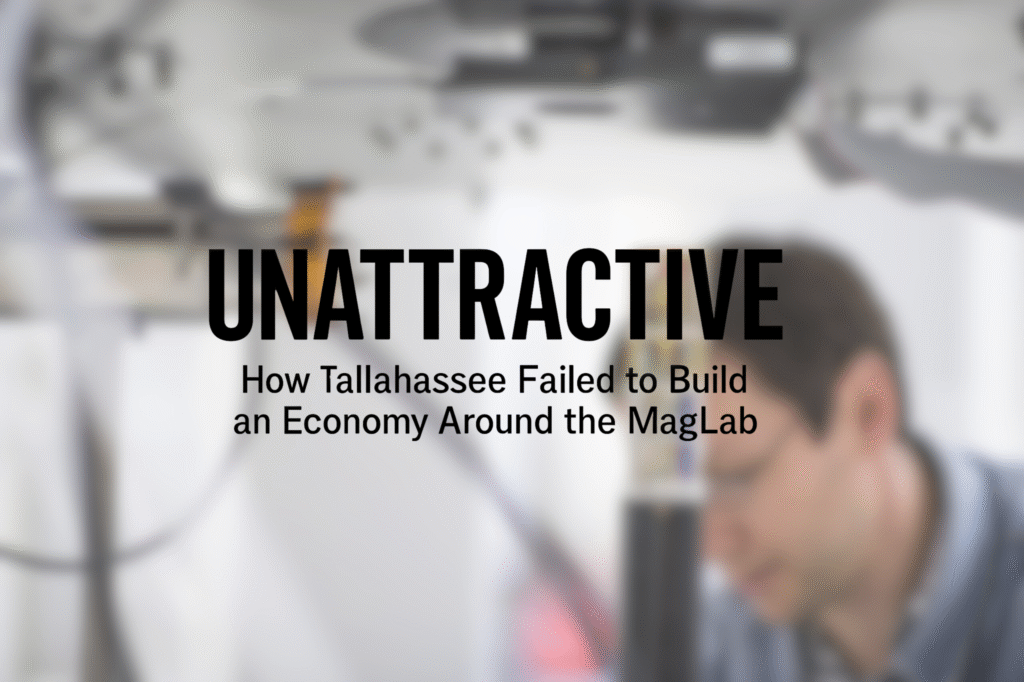
1. The self-evaluation problem
FSU regularly publishes economic impact reports estimating the MagLab’s local annual output. However, these reports are produced by FSU’s own research center (CEFA) and rely heavily on FSU-generated spending data, rather than independently audited outcomes or private-sector-led growth.
This raises concerns about potential bias and the absence of independent validation.
2. A culture of insularity
While many universities collaborate with local stakeholders, FSU appears to operate with limited outward engagement. Although Innovation Park – over which the university now has much more control — hosts some private sector entities, it remains predominantly academic and research-focused, rather than a thriving hub of public-private innovation. And there is no way around the fact that the park’s location – save for its proximity to the airport – is not desirable.
3. Gatekeeping vs. partnering
Some business leaders feel FSU treats the MagLab as its own asset—rather than a community resource. Further, FSU does not give the MagLab its own voice to be a community resource because all the business-related deals must go through FSU-sponsored research.
These perceptions may ultimately undermine trust and deter entrepreneurial or investment opportunities.
4. No clear economic vision
FSU lacks a visible, comprehensive plan to translate the MagLab’s scientific strengths into a citywide economic strategy. Unlike institutions that launch innovation districts, venture funds, or commercialization pipelines, no comparable effort is evident here.
What Could Change
This isn’t a critique of FSU’s scientific excellence but a call for strategic recalibration. FSU should:
- Invite independent review of its economic impact claims.
- Formulate a public-private economic growth strategy centered around the MagLab.
On this point, there are numerous examples of institutions that have taken the lead. North Carolina State University’s Centennial Campus in Raleigh is a 1,300-acre, university-planned public-private research community that intentionally recruited more than 75 corporate, government, and nonprofit partners to co-locate with academic departments and research centers — creating thousands of private-sector jobs and driving Raleigh’s transformation into a tech hub. Similarly, Arizona State University’s SkySong Innovation Center redeveloped a shuttered mall into a thriving mixed-use campus housing over 80 companies, blending academic research with industry to generate sustained regional investment and employment. These projects weren’t incidental spinoffs — they were university-designed strategies to harness institutional assets for local economic growth. - Expand partnerships with private-sector firms, accelerators, and developers.
- Reposition itself not only as a scientific steward, but as a partner in regional prosperity.
If the MagLab is truly a national asset, its benefits should reach beyond campus boundaries.
And then the burden shifts to other stakeholders:
Local government: The lack of a community economic development vision is apparent to anyone paying attention. That has to change. Further, businesses that visit our market lament the bulky, clumsy structure of the Office of Economic Vitality with its unclear lines of decision-making and lack of dexterity. That has to change, too.
State government: Understandably, Tallahassee is viewed as a business-unfriendly, anti-growth, hyper-political town. But the potential of a MagLab-driven economy is too great to let those realities overcome it.
Private sector: The Chamber has simply not been effective in convening the public sector stakeholders to solve this problem. Perhaps a different group of strong business leaders is up to the challenge.
Coming next: Is it too late? (Spoiler alert: No)
September 15, 2025Red Tape Florida
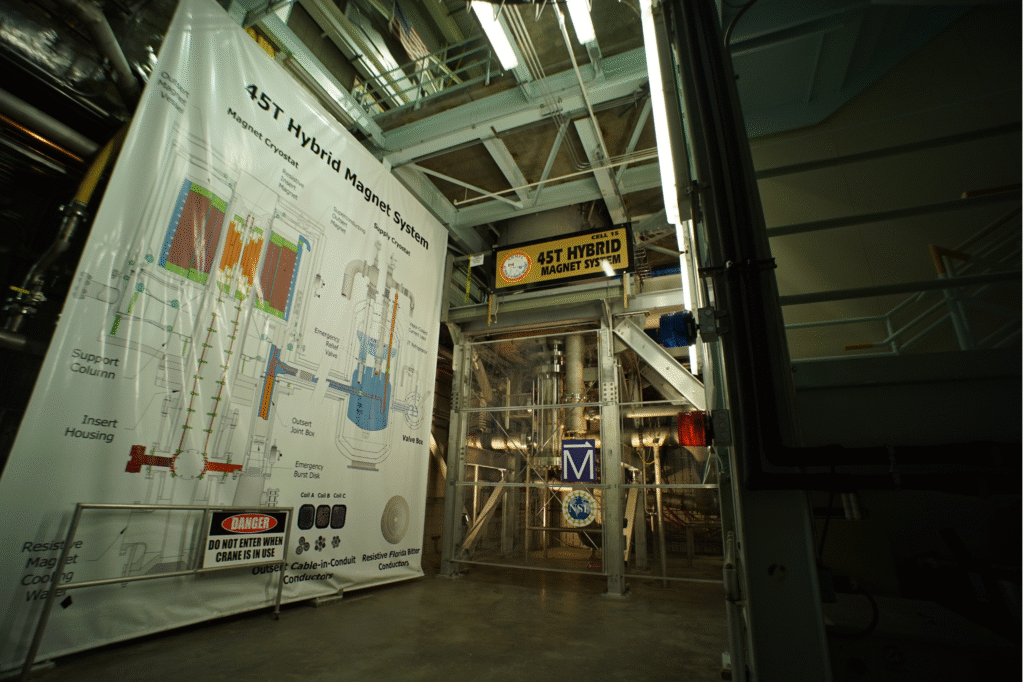
What could have been built around the MagLab (and what still could be)
In August 1990, the National Science Foundation awarded the National High Magnetic Field Laboratory to FSU — a decision that surprised many, including MIT, which had operated the Francis Bitter National Magnet Laboratory for 30 years. The original promise was vivid: a world-class scientific facility anchoring Florida’s capital city in the emerging area of magnetics. […]
September 11, 2025Red Tape Florida
What could have been built around the MagLab (and what still could be)

Part 3 of a series
In August 1990, the National Science Foundation awarded the National High Magnetic Field Laboratory to FSU — a decision that surprised many, including MIT, which had operated the Francis Bitter National Magnet Laboratory for 30 years. The original promise was vivid: a world-class scientific facility anchoring Florida’s capital city in the emerging area of magnetics.

Three decades after FSU won the competition to host the National High Magnetic Field Laboratory, the scientific mission of the MagLab is undeniably successful — the lab holds multiple world records and attracts top researchers from around the globe. But in terms of local economic impact, the results have fallen short of the original vision.
So, what would success have looked like? Here are four areas where Tallahassee has not kept pace with other national lab communities — and where it still has an opportunity to improve:
1. A research park that catalyzes private-sector growth
In thriving innovation districts, anchor institutions spark the development of adjacent private-sector firms. At Los Alamos and Oak Ridge, for example, national labs are surrounded by ecosystems of federal contractors, startups, and applied research firms.
Tallahassee’s, by contrast, is dominated by public and academic entities. It mainly consists of empty lots and aging buildings, except those built by FSU which have no connection to the MagLab. As detailed in part 2, the commercialization pipeline remains underdeveloped.
2. A tech corridor with venture capital and startup activity
Florida ranks among the top ten states for total venture capital investment — but virtually none of that flows through Tallahassee. From 2012 to 2021, the state attracted over $85 billion in VC and private equity, with nearly all of it concentrated in Miami, Tampa, and Orlando.
In Tallahassee, tech-based entrepreneurship remains rare, and there are very few examples of biomedical spinoffs or next-generation materials companies directly tied to MagLab research.
3. Strategic alignment between lab, government, and infrastructure
Cities like Los Alamos and Oak Ridge benefit from coordinated local and state investment in infrastructure, workforce development, and commercialization strategies to support lab spillover.
Tallahassee lacks such alignment. Its electric grid and zoning regulations have not been meaningfully modernized to attract energy-intensive firms. And the MagLab has also failed to embrace current energy solution technologies, instead choosing to stay the course from the early 1990s on how energy is managed – which is wasteful given what is available today.
4. Brand equity and national recognition
The MagLab is recognized in the scientific community for its world-record magnets — but its national profile is surprisingly low outside of research circles.
Unlike Oak Ridge or Los Alamos, which are synonymous with scientific innovation, Tallahassee rarely markets the MagLab as a signature asset. That’s not a failure of the science — it’s a missed opportunity in branding and communications.
5. More and better energy capacity and usage
If Tallahassee ever hopes to build an innovation economy around the MagLab, a basic question must be asked: Is the city even equipped to support one?
The answer is: maybe, maybe not.
Start with electricity. The MagLab is a power-hungry facility — among the largest single energy consumers in the region. In summer 2024, reports circulated that Florida State University had been asked by the City of Tallahassee to shut down MagLab power operations for an hour due to load concerns. This raises a fundamental red flag about whether our city-owned utility can support the demands of energy-intensive research or industrial-scale commercial spinoffs.
One issue is that the MagLab is still using 1990s-era magnets that are high-energy consumers. Existing technology would make these magnets operate more efficiently and lower power consumption when it comes to cooling and powering the magnets.
The MagLab’s most powerful magnets can draw between 18 and 33 megawatts. At the upper end, that’s enough power to supply roughly 20,000 U.S. homes. Tallahassee apparently has no surplus generating capacity – where would the power come from if a new data center, battery plant, or high-wage advanced manufacturer was eyeing Tallahassee?
6. Site readiness
Beyond electricity, there’s also site readiness. Tallahassee lacks shovel-ready parcels that are truly equipped for tech-sector investment. In communities like Oak Ridge and Los Alamos, federal labs are surrounded by pre-zoned, utility-ready development pads supported by regional industrial recruitment efforts. Not so here.
Bottom line: Even if the MagLab did produce a wave of commercialization, it’s unclear whether Tallahassee could physically support the growth. Our infrastructure isn’t ready, our energy grid is strained, and our land inventory is weak.
The Good News
It’s not too late. The MagLab remains among the world’s top facilities in its field. Realizing its broader potential will require:
- A serious commercialization strategy
- Infrastructure enhancements to attract private investment
- Deliberate partnerships across academia, government, and industry
- Independent economic metrics and bold regional targets
A world-class lab deserves a world-class regional strategy. Tallahassee has a second chance — if its leaders seize it.
Coming next: Is this an FSU problem or an all-the-other-stakeholders problem?
September 11, 2025Red Tape Florida

“Completely inappropriate”: Local, state leaders outraged over luxury watch gift
Leon County Commission Chair Brian Welch blasted actions by the North Florida Fair board on Friday as “completely inappropriate and utterly confounding,” adding he will seek a review by both Leon County Government and the Blueprint Intergovernmental Agency to determine “what level of oversight we have in the management of the fairgrounds.” […]
September 9, 2025Red Tape Florida
“Completely inappropriate”: Local, state leaders outraged over luxury watch gift

Leon County Commission Chair Brian Welch blasted actions by the North Florida Fair board on Monday as “completely inappropriate and utterly confounding,” adding he will seek a review by both Leon County Government and the Blueprint Intergovernmental Agency to determine “what level of oversight we have in the management of the fairgrounds.”
“I cannot believe that a non-profit board that oversees the administration of a public asset would act in such an irresponsible way,” Welch wrote. “I intend to ensure that both Leon County Government and the Blueprint Intergovernmental Agency investigate this situation as soon as possible.”
Tallahassee City Commissioner Jeremy Matlow also weighed in on Red Tape Florida publisher Skip Foster’s Facebook page saying the gift was “incredibly out of touch.”
Florida State Rep. Allison Tant also registered her outrage: “If this watch was paid with anything supported by tax dollars, it should be returned and refunded,” Rep. Tant said. “And the fairground authority should be audited. This is not what public or not-for-profit funds should be used for.”
Welch’s post landed as social media comments were unanimously outraged and featured calls for accountability. A sampling:
Anger over spending and priorities
- “Blatant misuse of funds.” — Allison Flynn
- “Personally, I don’t think anyone should have a $35,000 watch when children are homeless and/or going hungry!” — Liz Jameson
- “$200 watches work just as well.” — Colleen Castille
Credit for dissent and calls to return money
- “Proud of Rachel Sutz Pienta and the others who resigned. Now, how about the director refuse to take it and return the $? That’s what should happen next.” — Carrie Boyd
- “What incredible audacity! … Bravo to Rachel Sutz Pienta and the other board members who refused to go along with this…” — Rick Oppenheim
Governance and oversight concerns
- “Truly outrageous. I wonder if an audit would reveal other reckless expenditures.” — Bill Berlow
- “The fairgrounds board has had a cloak of protection… They answer to no one. This can only change with leadership addressing it.” — Henree D. Martin
- “This is the ‘rest of the story’ I’ve been waiting for.” — Pam Jordan Anderson
Bigger-picture ideas
- “The fairgrounds need to relocate to Gadsden County. Become truly regional.” — Ed Murray Jr.
Why it matters
The North Florida Fair is run by a private not-for-profit association but operates a community asset and regional venue. That public–private mix is fueling questions about who sets the rules, how directors are chosen, and what public oversight exists.
What’s next
- Welch says he’ll press for County/Blueprint inquiries into oversight levers (leases, grants, interlocal agreements).
- Commenters are calling for the Fair Association to publish its bylaws, explain how board seats are filled, and return any inappropriate purchases.
- Several readers urged a full audit and a public workshop before any board changes move forward.
RTF has requested the association’s governing documents and any county/Blueprint agreements related to the fairgrounds. If you have records or perspectives to add, email info@redtapeflorida.com.
September 9, 2025Red Tape Florida

$35,000 retirement watch for North Florida Fair manager prompts board resignations
The non-profit North Florida Fair Association board has voted to spend roughly $25,000 on a luxury retirement watch for longtime fair manager Mark Harvey, based on public records obtained by Red Tape Florida. […]
September 8, 2025Red Tape Florida
$35,000 retirement watch for North Florida Fair manager prompts board resignations

The non-profit North Florida Fair Association board has voted to spend roughly $25,000 on a luxury retirement watch for longtime fair manager Mark Harvey, based on public records obtained by Red Tape Florida.
That number bears repeating: twenty-five thousand dollars. On a watch. For a man already paid over $174,000 a year in salary, bonus, and benefits from a nonprofit that exists only because of public trust and taxpayer-owned land. Combined with a $10,000 donation from a fair vendor, it adds up to a $35,000 retirement gift.
The razor thin 5-4 vote led to multiple resignations from the board, including by its president and secretary.
How We Got Here

The idea began innocently enough. Some board members floated the notion of a nice retirement gift for Harvey, who, by all accounts, has had a long and successful run as the fair manager.
But it quickly spiraled. Pressed by a board member to choose a gift, Harvey identified an Audemars Piguet Code 11.59, a high-end timepiece more likely seen on Wall Street than at a county fair. At one point, a $42,000 Rolex was even under discussion.
To defray the cost, a vendor pledged $10,000. The rest — about $25,000 — will come directly from fair funds.
The Dissenters
Not everyone was willing to sign on. In his resignation letter immediately after the meeting, board secretary Steve Hurm cited Florida Statute 616.07(2), which makes clear that fair association property is public property to be held in trust for the “legitimate purpose of the association.” He argued that spending tens of thousands on a luxury watch flouted that responsibility.
Board president Rachel Pienta echoed the concerns in her resignation email, warning she could not defend the board’s action. Their point was straightforward: nonprofits benefiting from public assets cannot treat themselves like private clubs or corporations. Also submitting resignations: board members Ashley Edwards and David Gardner.
How the Vote Went Down
If the substance was troubling, the process was worse. After a June meeting lost its quorum, the board initially conducted an email “survey” vote, even though one board member had warned that such votes are improper and have no standing under Robert’s Rules.
That vote was deemed invalid and at the board’s specially called July 7 meeting, the $25,0000 expenditure was approved by a 5-4 vote.
The Optics
The fairgrounds sit in a neighborhood where the median household income is around $25,000 — less than the cost of this watch. The board’s decision effectively told those families: we think a departing executive’s wrist deserves more than what you live on for a year.
This is, at best, colossally bad judgment.
The new fair manager, Miranda Muir, denied a Red Tape Florida public records request stating that the association is “not subject to the State of Florida Sunshine Laws.” Hurm, an attorney, disagrees. He warned the board in a May 7 email that “this is not something we can discuss or vote on without violating the Sunshine law.”
Red Tape Florida was able to obtain the documents despite Muir’s stonewalling.
Why It Matters — and the RTF Connection
The North Florida Fair Association is not a private outfit. It is a nonprofit that exists because of public trust, tax-exempt status, and free use of Leon County land, including taxpayer-funded improvements. To wit, it has recently been in the news because more than $30 million of taxpayer dollars have been allocated via Blueprint 2020 to improve the fairgrounds’ facilities.
With these public dollars come an obligation to act as stewards, not spendthrifts.
Instead, the board demonstrated the classic symptoms of bureaucracy-creep that Red Tape Florida was built to expose. Quasi-public bodies, cushioned by tax breaks and government assets, start operating as if the rules don’t apply to them. Transparency slips, accountability erodes, and insiders reward themselves at the public’s expense.
The fair itself remains a cherished community institution. But its board just sent a message that stewardship takes a back seat to self-indulgence. We salute the board members who resigned in protest – this action was indefensible and wrong.
A watch may tell time, but this one tells a deeper story — of poor judgment, of blurred lines between public and private, and of how easily trust can be squandered. Unless new board leadership steps in, the North Florida Fair Association may find that credibility, once lost, is far harder to buy back than any luxury timepiece.
September 8, 2025Red Tape Florida
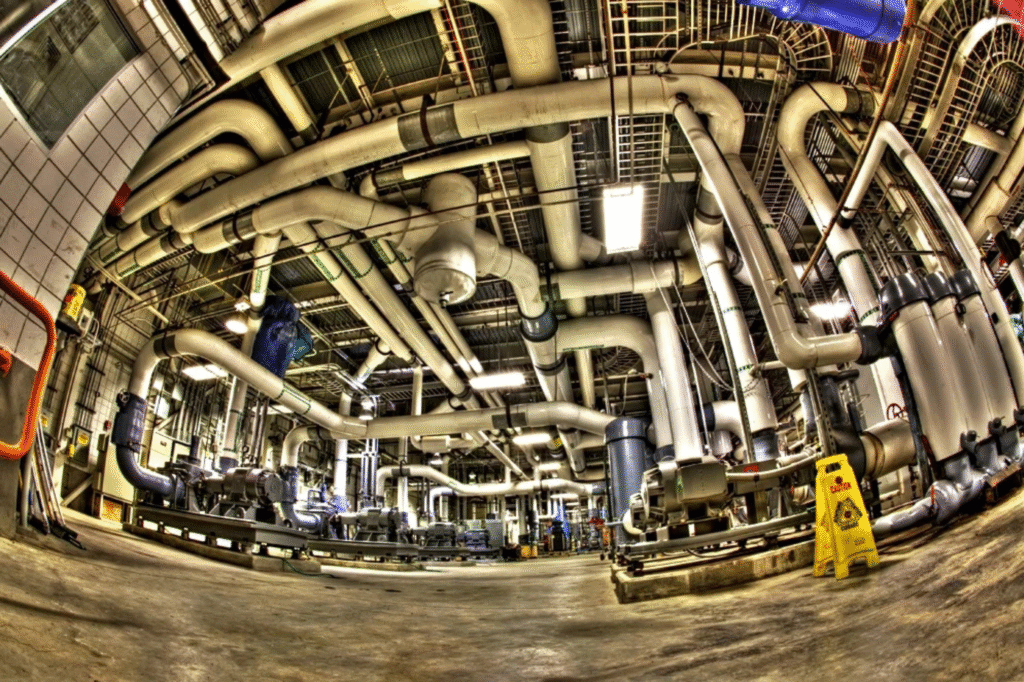
The missing middle — Why Tallahassee’s magnetics ecosystem never formed
A research facility doesn’t create economic value by itself. It needs an ecosystem — private-sector firms, infrastructure, and capital — to translate science into jobs. Tallahassee has failed to build that.[…]
September 4, 2025Red Tape Florida
The missing middle — Why Tallahassee’s magnetics ecosystem never formed

Part 2 in a series
A research facility doesn’t create economic value by itself. It needs an ecosystem — private-sector firms, infrastructure, and capital — to translate science into jobs. Tallahassee has failed to build that.
The reasons are structural:
- Limited commercialization pipeline.
Florida State University has not established a robust tech-transfer process to consistently spin out companies from MagLab research. In fiscal year 2023, FSU generated just $251,000 in licensing and royalty revenue, a modest figure compared to top-performing research universities.
- Lack of a corporate cluster.
Unlike national labs such as Oak Ridge and Los Alamos, the MagLab is not surrounded by a dense network of R&D firms or advanced manufacturers. Even within Innovation Park, there is little evidence of a thriving private-sector ecosystem linked to the lab’s research.
- Inadequate infrastructure.
Tallahassee’s electric grid, industrial land supply, and air travel connectivity are frequently cited by site selectors and business leaders as barriers to growth. The MagLab itself accounts for 7–8% of the city’s total electricity use — and reports suggest it has been asked to reduce load during capacity constraints.
- No targeted incentives.
Unlike Oak Ridge, TN — where city and county officials have deployed tailored incentive packages to attract lab-adjacent companies — Tallahassee and Leon County have no specific economic development tools tied to the MagLab’s potential spinoffs or commercialization opportunities.
- Insufficient marketing.
There is no dedicated marketing campaign to promote the MagLab to corporate site selectors, research parks, or innovation investors. Though the MagLab is featured in some general OEV (Office of Economic Vitality) materials, there is no sustained marketing outreach effort positioning it as a business development asset.
- Community culture unfriendly to business
Tallahassee’s reputation precedes – it is widely known in business circles that the city is not easy to work with when it comes to permitting and economic development. OEV’s clunky structure prevents even talented leaders from succeeding.
Despite the reality on the ground, FSU often touts the MagLab’s economic development impact on the community. But things aren’t as rosy as the picture that is painted.
Economic ‘impact’
At first glance, the economic impact figures associated with the MagLab sound impressive. Florida State University and its supporters often cite large numbers — including a $325 million annual statewide impact. But these estimates rely heavily on internal modeling, and a closer look at the components raises questions about what kind of impact is really being measured.
Let’s break it down.
1. Who created the impact estimates?
The most commonly cited impact numbers trace back to FSU-affiliated analysts (CEFA) and FSU publications, not an independent third party — e.g., $325M statewide (FSU BOT materials) and $221M Tallahassee / $325M Florida (MagLab “Economic Impact” PDF sourced to CEFA 2019). To date, there is no publicly available economic impact report on the MagLab conducted by an unaffiliated national consulting firm or neutral economic research organization.
2. What’s actually included in the “impact”?
The $325 million impact figure includes:
- Salaries and benefits paid to lab and university staff;
- Federal and state funding allocated to the lab;
- Construction, equipment, and operational spending;
- Indirect and induced effects estimated from lab visitors, vendor spending, and employee consumption.
These are typical components of input-output modeling — they reflect the flow of public funds through the regional economy. In other words, much of the “impact” represents economic activity, not necessarily private-sector growth or wealth creation. There is little in the estimate to suggest substantial returns in the form of new tax revenue, private investment, business formation or job creation.
Unfortunately, these numbers are usually lapped up or parroted by business advocates and the media.
3. What’s missing from the equation?
In economic development terms, the presence of a high-profile research facility like the MagLab would ideally spark spinoff companies, attract venture capital, support industry partnerships, and expand the local tax base. However, publicly available reports and presentations from the MagLab do not document a pattern of commercialization successes, private-sector relocations, or large-scale job creation beyond the lab itself.
One exception is Danfoss Turbocor, a private manufacturer that has cited the MagLab as a factor in its decision to grow in Tallahassee — a point noted in an FSU Board of Trustees presentation.
4. How does MagLab compare to national peers?
Consider Oak Ridge National Laboratory (ORNL) in Tennessee, which has built a significant economic ecosystem around federal research. DOE’s Oak Ridge Reservation — which includes ORNL — generated $7.2 billion in economic impact and supported ~43,000 jobs in Tennessee in FY2020 (ETEC/Baker Center study). ORNL’s role is amplified by robust technology transfer and manufacturing partnerships.
Now, again, to be fair, ultra-high field magnets (the Mag Lab’s primary focus) have limited manufacturing purpose right now. But that didn’t stop Danfoss from seeing the potential of an ecosystem forming and of the proximity to research.
Even accounting for scale differences, the gap in economic reach and private-sector spillover is substantial. Despite being a world-class scientific asset, the MagLab has not yet catalyzed a broader innovation or manufacturing cluster in Tallahassee.
Bottom line
The MagLab’s economic impact claims are based on modeling of public spending and its local ripple effects — not on independent analysis of long-term economic transformation. While the lab clearly delivers scientific value and supports high-wage public-sector employment, the evidence for substantial private-sector growth around it is limited. An independent economic assessment could help clarify the lab’s true role in regional development — and what might be done to enhance it.
Coming next: What could have been and could still be
September 4, 2025Red Tape Florida
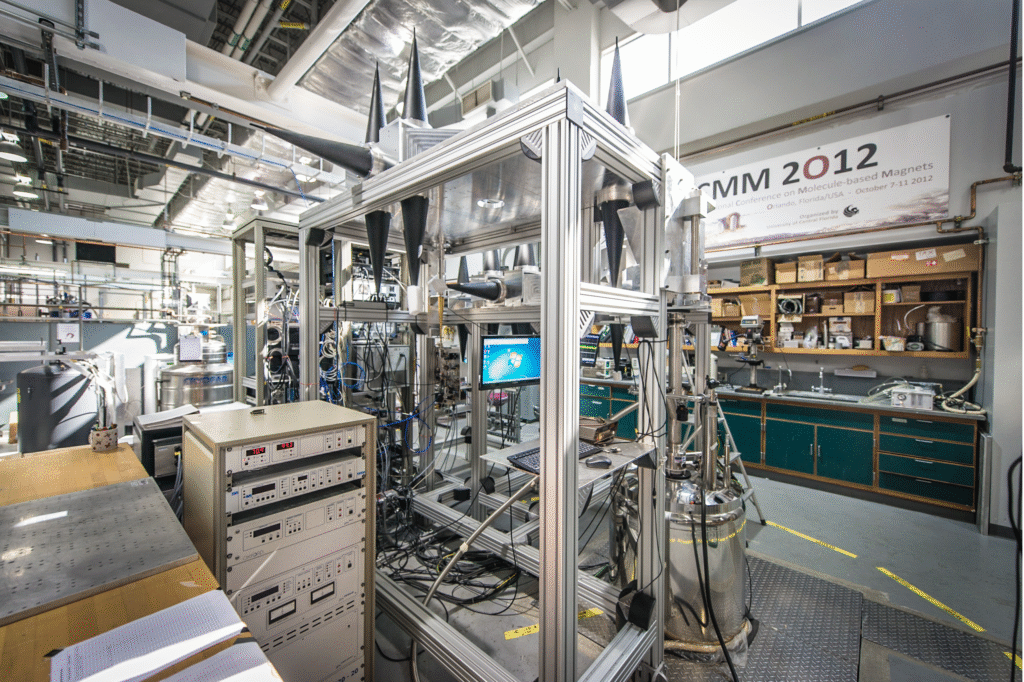
SPECIAL REPORT: How Tallahassee failed to build an economy around the Mag Lab
In the early 1990s, Tallahassee won what looked like a jackpot: the National High Magnetic Field Laboratory. With more than a billion dollars in federal investment, a dedication ceremony featuring Vice President Al Gore, and Gov. Bob Graham hailing it as a “lynchpin of economic development,” the MagLab was sold as Tallahassee’s ticket to a high-tech future. […]
September 2, 2025Red Tape Florida
SPECIAL REPORT: How Tallahassee failed to build an economy around the Mag Lab

Introduction
In the early 1990s, Tallahassee won what looked like a jackpot: the National High Magnetic Field Laboratory. With more than a billion dollars in federal investment, a dedication ceremony featuring Vice President Al Gore, and Gov. Bob Graham hailing it as a “lynchpin of economic development,” the MagLab was sold as Tallahassee’s ticket to a high-tech future.
The promise was classic government pitch: build a world-class research facility and the private sector will follow. Startups will sprout, high-wage jobs will cluster, and a sleepy capital city will become a science and innovation hub.
Three decades later, the private-sector return can be counted on one finger. Aside from oft-cited Danfoss Turbocor, there’s no visible cluster of spinoffs or manufacturing base tied to MagLab expertise. The only impact figures in circulation are FSU-affiliated: an earlier CEFA study estimated about $90 million a year in economic output for the Tallahassee MSA; newer FSU/CEFA materials scale that to ~$221 million in Tallahassee and ~$325 million statewide, numbers subsequently echoed in Board of Trustees decks and congressional letters. These are input-output accounting results built largely on university payroll and procurement, not independent evidence of new enterprise formation.
This disconnect between the hype and the reality is exactly why Red Tape Florida exists. Too often, bureaucrats and institutions oversell projects, pocket the accolades, and move on — while taxpayers and communities are left wondering where the promised growth went. If the MagLab had landed in Austin, Raleigh, or Nashville, would it have been wasted potential or a genuine catalyst? Tallahassee’s record speaks for itself.
The MagLab is an incredible scientific asset. And there are hopeful signs, including strong research performance and the return in 2026 of an important magnetics conference to Tallahassee.
But as an economic engine, it’s a cautionary tale of bureaucratic inefficiency and missed opportunity. Over the next several installments, Red Tape Florida will dig into how this happened, what lessons can be learned, and what it will take to finally turn an expensive, underperforming government project into the spark of private-sector growth it was supposed to be.
Part 1: Los Alamos vs. Tallahassee — A Tale of Two Lab Towns
To understand what’s missing in Tallahassee, consider Los Alamos, New Mexico — home to another National Science Foundation-supported lab: Los Alamos National Laboratory (LANL). The contrast is striking.
LANL has been a magnet for defense tech firms, manufacturing contractors, and federally funded spinoffs. More than 600 companies are part of the regional contractor network. The lab directly or indirectly supports over 25,000 jobs in the state — many in the private sector.
Meanwhile in Tallahassee, the MagLab supports fewer than 500 jobs — most of them public university employees. There is no comparable cluster of firms, no surge of startups, no downstream manufacturing ecosystem.
Why the difference?
First, to be fair, Los Alamos and Tallahassee are not perfect analogs. LANL is a massive national security lab with a multibillion-dollar budget and a mission tied directly to federal defense contracting. The MagLab is smaller, academically focused, and funded by the National Science Foundation.
But that doesn’t excuse the failure to build any real ecosystem around a world-class research facility. Other communities have done far more with less.
Take for example the Sandia Science & Technology Park in Albuquerque — 44 companies/organizations, 2,018 on-site employees (July 2025), nearly $500M cumulative public+private investment and 25-year impacts include $7.7B in wages and 6,500+ jobs tied to park companies
LANL’s operator, Triad National Security LLC, actively recruits corporate partnerships and administers grants to private companies. In contrast, the MagLab is operated by a public university and has focused primarily on academic research — not economic development. The new regime in Wescott has promised more results in this area. So far, evidence is hard to find.
In Los Alamos, the lab is an anchor for a private-sector ecosystem. In Tallahassee, it’s a silo.
Basically, it boils down to leadership and collaboration.
Coming next: The missing middle – why Tallahassee’s ecosystem never formed.
September 2, 2025Red Tape Florida
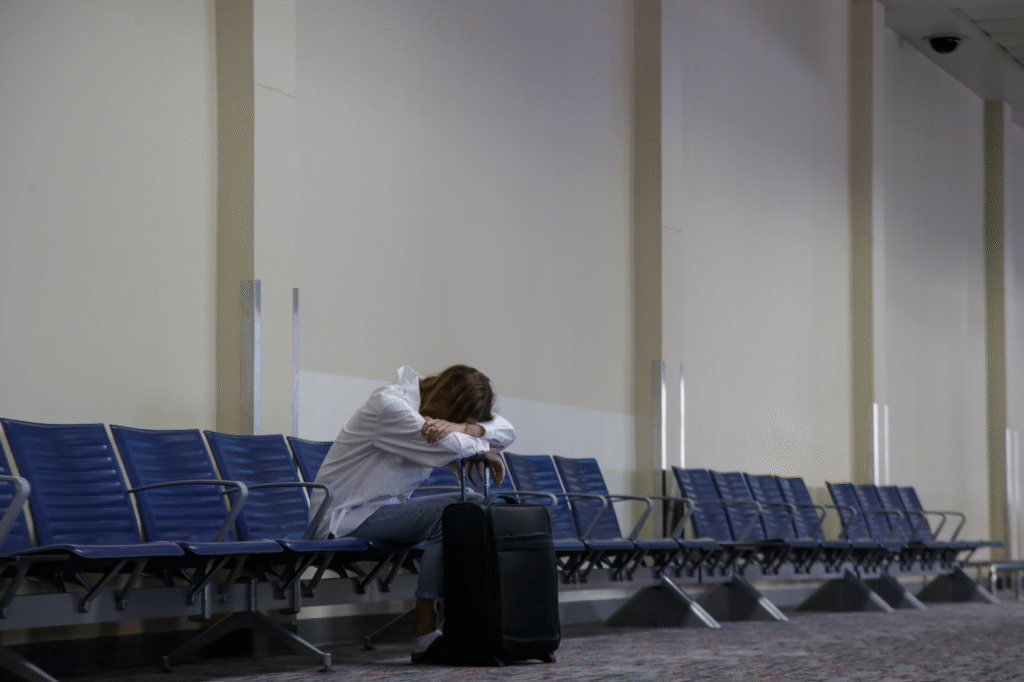
Runway closed; flights diverted … but not a peep from TLH airport about major disruption
Last night, Tallahassee International Airport pulled off the rare double-play of shutting down both of its runways — and its communications channels. One runway was already closed for construction. The other was blocked by a disabled aircraft that the airport apparently couldn’t move because they didn’t have the right equipment. The result: inbound flights were told midair to turn around and head elsewhere. […]
August 12, 2025Red Tape Florida
Runway closed; flights diverted … but not a peep from TLH airport about major disruption

Last night, Tallahassee International Airport pulled off the rare double-play of shutting down both of its runways — and its communications channels. One runway was already closed for construction. The other was blocked by a disabled aircraft that the airport apparently couldn’t move because they didn’t have the right equipment. The result: inbound flights were told midair to turn around and head elsewhere.
One Dallas–Tallahassee flight got within minutes of landing before being sent all the way back to Texas, where passengers landed at 11:15 p.m. Eastern. From there, they were told to “sit tight” while the airline figured out whether to put them up overnight or send them back to Tally on another plane.
You might think an airport with 58 full-time employees and a $19 million budget would be able to tell the public what was going on. You would be wrong. TLH’s social media feeds were a graveyard — the airport’s X (Twitter) page hasn’t posted since May, and not a single real-time update appeared last night. The only official, public-facing acknowledgment of the problem came from the FAA’s status page, which blandly reported a “disabled aircraft on the runway” with an end time around 10:30 p.m. Eastern.
It’s not like the airport shouldn’t be able to handle communications with that budget, but even if they can’t, we respectfully point out that the City of Tallahassee Communications department has 9 staffers and a budget of almost $1.5 million. Surely between the 67 staffers in those two departments there is somebody who can alert travelers about a major disruption.
If this were a one-off, maybe it’s just bad luck. But Red Tape Florida has reported before on operational gaps that go beyond the occasional mishap. In March, flight delays left planes sitting on the tarmac. One passenger said the pilot announced that: “Their one maintenance contractor lives 45 min east of town and has to drive in whenever there’s sign off needed.”
Tuesday night’s silence is especially baffling given that TLH is in the middle of a major airfield rehab project — including work on Taxiway B approved this spring — which already reduces runway capacity. When you’ve only got one usable runway, you’d think “publicly explain when it’s closed” would be at the top of the to-do list. Apparently not.
This isn’t about whether an airport can prevent a mechanical issue — it can’t, and no one expects it to. It’s about whether they can grab their phone, type “Runway closed due to disabled aircraft, expect diversions” and hit “post” before hundreds of passengers find out the hard way from a pilot in a holding pattern – not to mention friends and family waiting on the ground.
If Tallahassee International wants to be taken seriously as a growing regional hub, it might start by proving it can communicate during the most basic of operational hiccups. Last night, runways for airplanes — and runways for communications — were all closed.
August 12, 2025Red Tape Florida

Energy Capacity: The Quiet Variable in North Florida’s Economic Future
A recent concept paper developed by Tallahassee State College and regional partners raises a vital question for those focused on growth in North Florida: Is the region’s energy infrastructure keeping pace with its economic ambitions? […]
July 31, 2025Skip Foster
Energy Capacity: The Quiet Variable in North Florida’s Economic Future

A recent concept paper developed by Tallahassee State College and regional partners raises a vital question for those focused on growth in North Florida: Is the region’s energy infrastructure keeping pace with its economic ambitions?
The document, titled North Florida Energy Futures and authored by Kyndra Light, Corporate Solutions Manager for Tallahassee State College, outlines a range of opportunities tied to manufacturing, logistics, and clean technology — but it also flags a significant limitation. Uncertainty around the availability and scalability of energy infrastructure, especially electricity, has already impacted the region’s ability to attract investment.
In fact, the paper confirms that some prospective economic development projects have been lost as a result.
In fact, just this week, power was cutoff and research suspended for an hour at the FSU National High Magnetic Laboratory because of peak power use during the recent heatwave. The MagLab uses as much as 8 percent of the city’s power.
This isn’t alarmism. The report frames the issue as a solvable challenge, but one that requires immediate coordination. It calls for the development of a Regional Energy Readiness Plan that brings together utilities, local governments, workforce partners, and economic development agencies. The goal: to assess current capacity, streamline planning, and identify where gaps may prevent future growth.
The report also hints at fragmentation. North Florida is served by a mix of municipal utilities, investor-owned providers, and electric cooperatives. Each has its own service territory and planning process. Without a shared understanding of regional energy availability, even the best-located sites may fail to meet the needs of modern industry.
For regions competing to land high-wage, high-skill jobs, energy availability is no longer a behind-the-scenes consideration. It’s a deal-breaker. Whether the focus is electric vehicle supply chains, advanced manufacturing, or data-driven logistics, companies need to know they can power their operations on day one — and scale that power over time.
The concept paper doesn’t point fingers. It offers a pragmatic roadmap for future coordination. But it does carry an implicit challenge to those in leadership: growth planning must account for energy planning. Without it, job creation strategies risk running into invisible walls.
For economic developers, planners, and public officials, North Florida Energy Futures is worth careful review. It’s a reminder that in the race to attract business investment, infrastructure still matters — and energy is at the heart of it.
July 31, 2025Skip Foster

The red tape machine doesn’t get its start in city hall — it cranks up in the comments
Last week, Ghazvini Development posted an aerial photo announcing their newest residential project: the Summerhill development on the northeast side of Tallahassee. The tone was upbeat — “Exciting news!” — and the land was pictured in a sunlit overhead shot, ready for transformation. […]
July 17, 2025The red tape machine doesn’t get its start in city hall — it cranks up in the comments

Last week, Ghazvini Development posted an aerial photo announcing their newest residential project: the Summerhill development on the northeast side of Tallahassee. The tone was upbeat — “Exciting news!” — and the land was pictured in a sunlit overhead shot, ready for transformation.
Then came the comments.
“Why do developers clear-cut all the trees?”
“So many trees…”
“Oh, another subdivision, yay…”
The outrage was fast, emotional, and utterly predictable.
This is now a standard feature of local development in Tallahassee: post → outrage → assumptions → pressure → process gridlock. And increasingly, this is where red tape is born — not in some back office at Growth Management, but in the comment section of social media.

Let’s take a closer look at that image.
To many, it triggered sadness or frustration — a large swath of green space on the cusp of change. But to others familiar with land use and forestry in North Florida, it looked familiar: rows of evenly spaced trees, planted in straight lines, bounded by clean property lines.
That’s the visual fingerprint of a managed pine farm, not a wild, old-growth forest. No one’s suggesting it wasn’t wooded. But the difference between a functioning timber tract and a natural ecosystem matters — and it’s a distinction lost in a digital environment where “tree = sacred” and “developer = destroyer” is the default.
It also misses the larger point: this land is zoned for development. This project is legal. And this city is growing.
According to the Tallahassee Board of Realtors, median home prices have surged nearly 40% in the last five years. Yet construction — especially of starter homes and workforce housing — has failed to keep up. The result? More demand, less supply, higher prices.
When public outrage triggers more hearings, more delays, and more regulation, it doesn’t protect the environment. It chokes affordability. It drives up the cost of every permit, every foundation, every final inspection. It turns the middle class into renters and the next generation into transplants.
And here’s the kicker: Tallahassee’s tree canopy is still over 55%, one of the highest in the country. That’s according to the city’s own Urban Forest Master Plan. In fact, many modern developments include mitigation requirements that replace more trees than are removed — just not in the exact place where someone used to jog.
We’re not saying development is always perfect. Or that criticism is always wrong. But we are saying this: when every new project is treated like a public emergency, the only guaranteed outcome is more red tape.
That’s bad for builders. But it’s also bad for neighborhoods. Because the more unpredictable the process becomes — the more it’s swayed by online emotion instead of transparent rules — the fewer people want to build here at all. And when they do, they pass the costs on to the very people who can least afford it.
This isn’t about defending developers. It’s about defending process — so that rules mean something and growth doesn’t become a game of political dodgeball, which often puts commissioners and staff in a very difficult position.
We can protect trees and build homes. We can plan responsibly without letting the loudest thread on Facebook become city policy.
Because if we keep letting the Facebook mob write the rules — the same people who cleared forests for the homes they live in — we’ll be left with nothing but pine trees and the broken dreams of the families who want to live in Tallahassee, but can’t.
July 17, 2025
Hurray for Tallahassee’s third All America honor! Now, let’s raise the bar even higher
Let’s start with this: Congratulations, Tallahassee!
Earning the title of All-America City — not once, not twice, but three times — is a big deal. This is not a participation trophy. It’s not something you buy. It’s something you earn by demonstrating that a community knows how to tackle challenges, bring people together, and chart a path forward.[…]
July 1, 2025Hurray for Tallahassee’s third All America honor! Now, let’s raise the bar even higher

Let’s start with this: Congratulations, Tallahassee!
Earning the title of All-America City — not once, not twice, but three times — is a big deal. This is not a participation trophy. It’s not something you buy. It’s something you earn by demonstrating that a community knows how to tackle challenges, bring people together, and chart a path forward.
That’s exactly what Tallahassee did. The Southside Action Plan. The Clean Energy Blueprint. The growing network of over 100 parks and public spaces. These aren’t just bullet points in a PowerPoint deck. They’re tangible investments in the kind of city we all want to live in.
This isn’t about who’s on what side of what debate. It’s not about politics. It’s about community. And it’s right to pause and take pride in a moment like this.
A spirit of collaboration
Look at the effort that went into this award submission — the planning, the execution, the collaboration. City staff. Nonprofits. Neighborhood leaders. Civic groups. Everyone pulling in the same direction to solve big problems.
It’s proof of something we sometimes forget: when Tallahassee aligns around a shared goal, big things happen.
And that’s not just theory. It’s a fact. Winning this award three times puts Tallahassee in rare company nationally. That’s a reflection of a community that knows how to work together, even when we don’t always agree on everything.
But what if we broadened our All-America horizons?
Here’s a thought: what if the same commitment that went into these public initiatives was applied to the barriers that hold back our private sector?
Because here’s something worth noticing. Every one of the projects highlighted in Tallahassee’s All-America application was a government-led effort. Not one featured the private sector at the center.
That’s not a criticism. It’s an observation. The award judges were right to reward these efforts. But anyone who’s built a business here, developed property here, or tried to navigate City Hall knows another side of the story.
For too many, navigating Tallahassee’s bureaucracy feels like a second job.
This city knows how to mobilize when it wants to. Knows how to plan. Knows how to execute. The question is: when will that same energy be aimed at removing the red tape that holds back the private sector?
And it turns out we’re not the only ones thinking about what’s next. Gus Corbella captured it beautifully in a recent column for the Democrat, writing about how much he loves Tallahassee — and how much more he wants to love about it. He’s right. The All-America award is a celebration of where we are. Now the challenge is deciding where we go.
The next All-America chapter is ready to be written
Imagine the next All-America application telling a story not just of government-led wins, but of a community that became the best place in Florida to start a business, to build a home, to invest in an idea.
What would that look like?
- A permitting process that takes days, not months.
- Zoning and development rules that solve the housing crisis instead of compounding it.
- A reputation as Florida’s most small-business-friendly city.
- An attitude shift—from “how can we regulate this?” to “how can we make this happen?”
This isn’t an either/or proposition. It’s both. Tallahassee can — and should — be a city that builds great public amenities and unleashes private-sector dynamism.
This community knows how to win – let’s do it again
The All-America award proves something important: Tallahassee knows how to collaborate, execute and win.
Now imagine putting those same skills to work — not just to build parks and plans — but to build prosperity, unlock opportunity, and clear the runway for anyone ready to take a risk on this city.
Yes, let’s celebrate this well-earned moment. And then let’s turn the page.
Let’s make Tallahassee an All-America city for entrepreneurs. For builders. For job creators. For anyone with a dream and the grit to chase it.
July 1, 2025